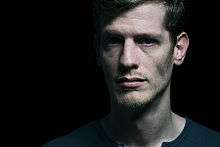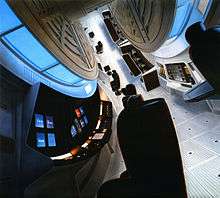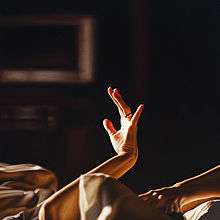Damian Loeb
| Damian Loeb | |
|---|---|
 Damian Loeb | |
| Born |
May 9, 1970 New Haven, Connecticut |
| Nationality | American |
| Education | Self Taught |
| Known for | Painting |
Damian Loeb (born 1970) is an American painter and photographer.
Loeb had his first solo show in 1999 at Mary Boone Gallery in New York. He has also exhibited at White Cube in London, the Jablonka Galerie in Cologne, and the Kunsthalle in Hamburg. A 2006 retrospective of his work was held at the Aldrich Museum of Contemporary Art[1] in Connecticut. He is represented by Acquavella Galleries.
Early work up to 2000
Loeb's early works were based on collages culled from varied sources, including advertisements, magazines, television, and books. The resulting paintings depict unsettling scenes rendered in a highly representational, seamlessly multi-layered composition. The atmosphere in the finished works expresses a dreamlike and surreal state, as if painted from an emotional memory. They allude to the work of John William Waterhouse or Andrew Wyeth, with surreal components plucked from postmodern culture.
Much of this early work gained him notoriety for his appropriation of images from contemporary media sources, and his paintings were the subject of several lawsuits brought by photographers over issues of copyright infringement. In 2004, controversy led to the removal of one of his paintings, Blow Job (The Three Little Boys) from a show at the University of Hartford.[2]
2000 to 2004

After the appropriation series, Loeb embarked on a series of paintings based on stills from classic horror and science fiction films. To create these works, he captured and digitally combined multiple stills which were then rendered as large oil paintings.
Many of the works take the form of extreme landscapes up to 14 feet long, engulfing one's field of view and reproducing the atmospheric elements of the scene without the use of recognizable or iconic signifiers.[3][4]
2005 to 2008
In September 2008 Loeb showed two new series of work at the Acquavella Galleries in New York. These included several large paintings which bore a striking resemblance to film stills, but were all based on the artist's own personal photographs. The tightly rendered paintings evoked the iconic narrative images embedded in the collective unconscious, illustrating the overlap between our memories of images from contemporary cinema and our ‘real world’ experiences.
In the second series of paintings, Loeb delved into the dark psychology of memory and emotion. These more loosely rendered pieces addressed psychological themes such as perception, distortion, fear, and fantasy in the form of small landscapes.
The addition of these works to Loeb's oeuvre has led one critic to describe him as a 21st-century J. M. W. Turner.[5]
2008 to 2011

In May 2011, Damian Loeb debuted a new series of figurative paintings at Acquavella Galleries titled Verschränkung and the Uncertainty Principle. The show consists of eight paintings based on a series of images he took of his wife Zoya over the past seven years. The title references paradoxes in quantum physics, wherein subject and object are rendered indistinguishable, (Verschränkung) and that the act of observation affects the object being observed (the Uncertainty Principle). The theory is used as a metaphor to examine the false barrier of safety imagined by observers and their culpable connection to the objects being scrutinized; as well as between artist and muse.
The paintings are reminiscent of Old Master portraits, though their apparent spontaneity belies the amount of work needed to create each, in the use of chiaroscuro, glazing, and classic composition. Typified by the up-stretched hand in early morning sun, the subject of Atmosphere (2010), these paintings have the ambiance of 17th century Baroque artist Georges de La Tour and the quiet tension of Gerhard Richter's photo-based work. All composed in square format, they depict the intimate moments of a life's narrative. Tension and melodrama are created by activating the relationship connecting the image and viewer through the inclusion of the optical vocabulary of cinematography and the allusion to the constraints of the instant polaroid. Thus bringing into question the act of voyeurism and the anticlimactic and revelatory nature of privacy. Gone is the rough, almost pixelated canvas of his previous work, instead for these new paintings Loeb used a more traditional, smoother linen, which more readily show off his unique skills as a craftsman, as well as an iconic image maker.[6][7]
2011 to present

In February 2014 Damian Loeb exhibited sixteen new paintings at Acquavella Galleries in New York.[8] The exhibition was titled Sol d, after an obscure cataloging term for Earth. The paintings shown varied in scale from large six foot by six foot compositions to smaller, more intimate oil studies. All were composed in a square format and depicted the moon, star-fields, the sun, atmospheric cloudscapes and terrains. The paintings offer a romantic parallel to the first-hand exploration of nature with charged remixes of picture postcard landscapes that challenge the perception of ocular space.[9]
References
- ↑ Aldrich Museum
- ↑ William Yardley (2004-10-12), Coincidence Sets Off Storm Over Erotic Work, New York Times, retrieved 2009-06-22
- ↑ Dannatt, Adrian (2003), The Art of Allusion, The Art Newspaper
- ↑ Edward Leffingwell (2003), Damian Loeb at Mary Boone, Art in America, retrieved 2013-04-01
- ↑ Finch, Charlie (2008), Comfort and Joy, Artnet Magazine, retrieved 2009-06-24
- ↑ Halperin, Julia (2011), The Redemption of Damian Loeb, ATINFO.com, retrieved 2011-05-11
- ↑ Damian Loeb at Acquavella Galleries, artdaily.org, 2011, retrieved 2011-05-11
- ↑ Acquavella Galleries, retrieved 2014-04-30
- ↑ Prentnieks, Anne (2013), Damian Loeb, Artforum, retrieved 2014-04-30